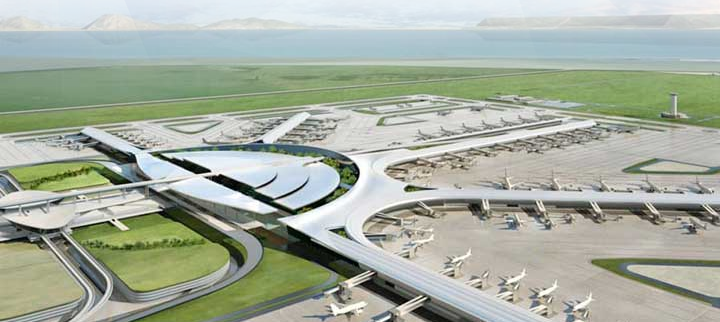Tycoon Ramon Ang, president of highly-diversified San Miguel Corp., is certainly lucky with his ultra-modern Bulacan International Airport, officially named New Manila International Airport, with the passage last Monday on third reading by the Senate of the bill creating the Bulacan Economic Special Zone and Freeport (BuZ) for its avowed economic benefits for the province, the region and the entire country.
The BuZ will complement the benefits of locating the international airport in Bulacan– despite earlier issues raised against the freeport zone being close to Subic and Clark freeport zones – that would accelerate economic activities, therefore economic growth in the region.
In July 2023– when the BuZ bill was vetoed by President Marcos– Ang lamented the challenges the bill was facing by stating that government stands to reap export revenues of $200-billion from potential foreign investors from the aviation, manufacturing, technology, education, healthcare and tourism industries, “if the vision for the Bulacan Airport Economic Zone is realized.”
Ang’s SMC is fully financing and building the P740-billion New Manila International Airport (NMIA) project in Bulacan and with the ecozone, would benefit the country and the Filipinos, if its full potential is realized.
Ang said the Bulacan airport economic zone, if approved, would be managed by the Philippine government, and any tax incentives to be given to investors will still pass the Department of Finance’s Fiscal Incentives Review Board (FIRB) review and approval process, to ensure these are aligned with the CREATE Law.
The CREATE Law was enacted to provide relief to foreign and local corporations already doing business in the Philippines, in light of the pandemic.
“Among our plans for the ecozone is to help create science and technology export hubs with the cheapest logistics cost, because these will be close to the airport and seaport. We are looking to attract world-class semiconductor manufacturers, battery power storage system manufacturers, electric vehicle makers, and even modular nuclear power assemblies and other new and emerging tech industries. We estimate these industries alone will add some $200 billion in annual exports—a big boost to our GDP,” Ang said.
Ang said he believes that the long-term benefits to the country of the ecozone would far outweigh and outnumber any supposed “losses” due to the grant of incentives to potential investors.
He said these benefits include hundreds of thousands of new jobs to be generated, which will benefit the next and future generations of young Filipino graduates, professionals, and skilled workers.
The transfer of knowledge and technology from foreign investors and locators, as well as access to world-class education and healthcare opportunities and services — industries the ecozone also looks to attract — would also be invaluable.
These are on top of the trillions in tax revenues that will accrue to the government for the entire lifetime of the ecozone and airport, coming from the various industries and institutions that will set up facilities and operations there, to take advantage of the low cost of logistics, incentives, and our country’s primary asset: a high-quality workforce, Ang explained.
“Incentives are a way for the government to attract much-needed investments into our country, especially now that we are all pulling together to help our economy not just recover, but continuously grow in the post-pandemic era. This way, our future generations will have enough and better opportunities than we have,” he said.
Ang also addressed the issue of NMIA being close to the Clark Airport, which was mentioned in the veto and was initially raised by the DoF under the previous administration, which said NMIA would “compete” with Clark International Airport.
Ang said that apart from the considerable distance between the two airports—Clark is approximately some 100 kilometers from Metro Manila—large and progressive cities all over the world employ a multiple airport strategy, such as Tokyo and New York, among others.
Additional infrastructure
Anticipating the long-term population and economic growth of Metro Manila and Luzon provinces in the next 20-30 years, and taking into consideration the limited expansion opportunities for the current gateway, Ninoy Aquino International Airport (NAIA)—which only has space for one runway operating at any given time, compared to NMIA’s four parallel runways—-the country would need several airports to efficiently serve Filipinos, tourists, and industries, Ang added.
SMC also leads the consortium that was recently awarded the rehabilitation project for the NAIA.
“What we don’t want is to repeat the mistakes of the past where we were not quick enough to develop new infrastructure, giving rise to overcapacity and congestion on our aging roads, ports, and other facilities, and even in our skies. Temporary fixes will not do anymore. We are building for the future, with a clear vision of a fully-developed and progressive, prosperous Philippines,” Ang said.
Ang said that regardless of the outcome of any further government review or action on the ecozone, SMC remains fully committed to continuing on its path of growth through nation-building, and building the NMIA—seen as the solution to decades of air traffic and land congestion that have severely limited the country’s growth.
“We believe in, and fully subscribe to President Marcos’ message of unity. It’s something we have always tried to demonstrate in many ways, particularly in times of great difficulty for our nation. We will do everything we can to help President Bongbong Marcos and his administration succeed, because their success is our country’s success. We look forward to working with them and contributing to their efforts to build our country back even better,” Ang said.
The Senate on Monday voted 22 to 0 SB 2572 creating the Bulacan Airport City Special Economic Zone and Freeport Act.
Sen. Grace Poe, who sponsored the bill, said she has high hopes for the Bulacan Ecozone or BuZ in spurring investments, creating more jobs and being a model, not just in the Philippines but all over Asia, of increasing GDP.
#WeTakeAStand #OpinYon
